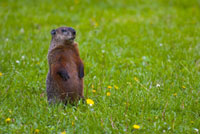Damage Identification
 The early morning and evening hours are preferred for feeding as woodchucks depend on dew for much of their water intake. They eat large quantities of succulent plants. Woodchucks can become a nuisance when their feeding conflicts with people's gardening efforts or when they dig burrows in hayfields. They may feed in gardens, flower beds, alfalfa and clover fields. Occasionally, woodchucks damage young trees in orchards or nurseries. Although woodchucks will climb trees, they prefer to eat fruit on the ground and normally do not cause damage by climbing trees to eat fruit.
The early morning and evening hours are preferred for feeding as woodchucks depend on dew for much of their water intake. They eat large quantities of succulent plants. Woodchucks can become a nuisance when their feeding conflicts with people's gardening efforts or when they dig burrows in hayfields. They may feed in gardens, flower beds, alfalfa and clover fields. Occasionally, woodchucks damage young trees in orchards or nurseries. Although woodchucks will climb trees, they prefer to eat fruit on the ground and normally do not cause damage by climbing trees to eat fruit.
Woodchucks often can be observed basking in the summer sun during the warmest hours of the day. They sleep on the tops of fence posts, on stone walls, large rocks, fallen logs and grassy areas, all of which are close to the burrow entrance. Even feeding woodchucks normally do not travel farther than 50 yards from their dens. There are exceptions as male woodchucks have been known to travel long distances to find a mate. And on occasions, woodchucks will travel several hundred yards for forage in time of drought or to eat fallen orchard fruit.
Dens are typically located on the edge of woodlands, in fields along fence rows, or in little used barns or sheds. Often woodchucks will take up residence in stonewalls or woodpiles, using several auxiliary dens for shelter.
The burrows dug by woodchucks are from 25- to 30-feet long and from 2- to 5-feet deep. Normally two or three entrances are used, although there may be as many as five entrances. The main entrance is identified by the mound of excavated dirt and stones that surround the entrance. A single chamber is formed at the end of the main entrance burrow, which is used for sleeping and the young. Another room is used for urination and defecation. In this way the den is kept relatively clean and free from disease.